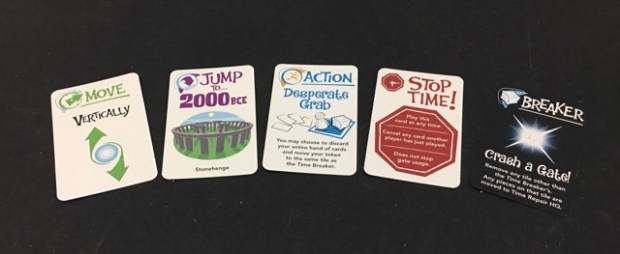Tabletop Tuesday – Time Breaker
I’m not going to lie – I like simple games that you can play with a small group of friends and be done in less than an hour (if not faster). Although I appreciate highly strategic games or those with long, complex stories, there’s something to be said for quick and simple fun.
This preference is why I have always been a fan of Looney Labs Games; the creators of Fluxx and Chrononauts. Their games are easy to learn, quick to play, and can be taken (and played) just about anywhere.
I already reviewed last year’s release, Get the MacGuffin, which is probably one of the fastest games they’ve created. Well, excepting those occasional Fluxx games where someone wins within the first couple of rounds.
This time I’m pleased to have gotten a chance to play their upcoming release, Time Breaker, and it holds up to the usual standards from Looney Labs.

Although this game of time travel might be mistaken for Chrononauts, the premise and mechanics are different. Time Breaker focuses on agents of the Time Repair Agency (TRA) attempting to catch a chrono-criminal who’s been changing history.
Players compete to find the criminal, arrest them, and bring them back to the agency. Whoever comes home with the Time Breaker first wins the game; be warned, however, as your fellow agents can cause the criminal to slip out of your hands and into theirs!
Gameplay is simple as each turn, a player draws a card and then chooses one of three possible actions: Play a Card (from their hand), Follow an Arrow (to the next natural location in the time-stream), or take a chance with a Wormhole (drawing a new card and playing it blind).
The goal is to get your game piece onto the same tile as the Time Breaker, declare their arrest, and then move yourself (and the criminal) back to the center tile (the Time Repair Agency). Sounds easy, except the time-stream is a jumbled mess and you must choose between following its natural flow (which can send you all over the place) or using your hand to move (to adjacent or specific tiles).

The game set-up has a 5×5 grid of time tiles, randomized, so each game is different, except for the central (home) tile. Each tile has a green and red arrow, telling the players which moments in time are before and after; when you Follow an Arrow, you take the green arrow to the next point in time (wherever that may be on the board).
Sometimes, however, it’s better to Move through time, vertically or horizontally, or Jump to specific eras. After all, why end up on the opposite side of everything, when your time machine can bring you directly to the Time Breaker.
As mentioned, however, each agent is out for themselves, and they have cards that can interfere with each other. Action cards might let you discard your hand in a Desperate Grab for the Time Breaker, move backward in time, or even force your fellow agents to move elsewhere; that latter is essential, because if you are moved (as opposed to moving yourself), then an arrested Time Breaker stays where they are and “escapes”!
Similarly, players can play Breaker cards to aid the criminal, causing him to move away from you (or out of your custody) or even allow them to escape and leave holes in time. In defense against each other, players can Stop Time with a specific card, canceling out their fellow agents’ betrayal (or success).
Also, an agent can “arrest” the Time Breaker in someone else’s custody, and it’s only the first player to move with them that keeps them! All these different actions against each other make Time Breaker extremely competitive (and downright vicious at times).

Time Breaker is a lot of fun, but its grid of tiles can be somewhat confusing at first, and even more-so as holes/gaps in the time-stream appear. The non-linear locations of each time period may have you staring as you try to figure out where each arrow leads.
Luckily, Looney Labs included nice artwork on each tile so you can just look for the visual graphics, like the first campfire in 1.5 million BCE or world peace (a peace symbol on the globe) in 2345. At first, I was a little dismayed, but then I realized the non-linear layout made sense both from a games’ mechanics and thematic, wibbly-wobbly, timey-wimey point-of-view.
Also confusing was the concept of Crashing Gates; we couldn’t tell at first that “crashing gates” and “removing tiles” was the same thing, and that you didn’t just flip them over but removed them from the board. The instructions did eventually explain this all, but (like the playing area) sometimes it took us a second to put the information in different paragraphs together.
To clarify, when Crashing Gates, the tile is removed completely to leave a gap on purpose. If you Move through time with cards, then you just jump over the gap (and even wrap around the board); if you Jump to that removed time period (or Follow an Arrow there), then you end up shunted back to HQ.
Once more, this ended up confusing at first but then making sense in the mechanics, as it affected travel. You could even use it as a quick strategy to win, as you might drag the arrested Time Breaker with you to the hole in time, instantly sending both of you back to HQ (for the win!).

In the interest of accessibility in tabletop gaming, I will note a couple of notes. One that struck me personally was found in the rules for Making an Arrest, which only requires that you “verbally declare” the act.
As a Deaf and Hard-of-Hearing advocate, I’m not a fan of focusing on verbal communication, as there are other ways for people to declare their intent. I realize that Looney Labs didn’t mean to exclude those who use sign language, cued speech, or other visual languages (as they can still state their intent in their own way) but seeing instructions that blatantly say “verbal” and “words you say” still feels exclusive in a game that otherwise isn’t hearing-focused.
I do appreciate the visual choices on the cards, as the colors chosen worked well. Actions are blue, Moves are green, and Jumps are purple; only Stop Times are red, and every card has text and graphics, so even red-green color-blind players won’t have too much problem.
Although the tiles use red and green arrows to indicate direction in the time-line, they use different styles and are easily understandable. The only color blindness confusion might come from two pawns (one red and one green), but as long as you’re not playing a five-player game there are other pawns (blue, purple, and orange).

Overall, Time Breaker is another success from Andrew Looney and his team. Although the instructions might have been more precise, and some word choices might have worked better, the game itself is a blast to play.
Its unique strategy, with the randomized grid, different movements, and cut-throat competitive maneuvers, led to a great game each time we played. Although advertised for 2-5 players, we preferred the 3-4 player range; at two players it sometimes devolved into an endless back-and-forth, and at five players sometimes the board ended up with a lot of crashed gates.
The game remained fun and replayable, just like many Looney Labs Games, and we had fun bringing it with us wherever we went.
Time Breaker hits shelves on Feb. 28th. 2-5 players, Ages 8+, 10-40 minutes.
We give Time Breaker a history-altering 4 quantum leaps out of 5.
(Thank you to Looney Labs Games for allowing us to preview their game!)


You must be logged in to post a comment.